11 Shade-Tolerant Plants That Come Alive in Autumn
Autumn brings cooler days that help many shade-loving plants show fresh color and texture. This season is a great time to notice how foliage can shift toward warmer tones, giving quiet corners of the garden a more lively feel. If you want to refresh shaded areas, this list highlights plants that stay interesting even as the weather changes.
This post may contain affiliate links, which helps keep this content free. Please read our disclosure for more info.
Heuchera

Heuchera brings a wide range of rich colors to shaded corners during autumn, and many gardeners appreciate how the leaves shift as temperatures cool. The foliage can move from warm greens to deep burgundy, plum, caramel, or copper, creating a layered look that feels tied to the season. These tones stand out even without flowers, making the plant reliable for anyone who wants autumn color in places that do not receive much sun. Its mounding habit adds fullness, and the leaves often hold their color well into the end of the season.
In addition to its seasonal tones, heuchera offers structure and texture that help fill gaps left by fading summer plants. It pairs beautifully with hostas, ferns, and woodland flowers, giving shaded beds a balanced look. Many gardeners enjoy mixing several varieties because the contrasting leaf colors create depth. Heuchera also handles cooler weather well, and it maintains fresh growth longer than many other perennials, which helps it stay attractive through the entire autumn period.
A third detail that adds to its appeal is how manageable it is in both small and large gardens. The plant works well along pathways, borders, and containers, and it suits many design styles. Its neat shape reduces the need for constant attention, leaving more time to enjoy the way its colors develop as the season moves forward. All of these qualities make heuchera a reliable choice when building a shaded autumn display.
Hostas

Hostas remain a favorite for shaded areas because their leaves stay strong, lush, and full through much of the fall season. Their large leaves offer a generous appearance that helps anchor garden beds as other plants begin to lose shape or color. Many varieties shift to soft gold, chartreuse, or warming green tones once autumn arrives, creating a calming display that suits shorter days and cooler air. Because they hold their leaves longer than many perennials, hostas bring steadiness to gardens that might otherwise feel empty.
Beyond their seasonal beauty, hostas help fill shaded gardens with layers and structure. They pair well with ferns, coral bells, and woodland plants, and their full leaves draw the eye even in low light. Gardeners appreciate how hostas work in both formal and natural-looking garden designs, and how they help guide the view through shaded beds. Their presence supports the overall look of the garden, giving it depth and shape throughout autumn.
Another reason they thrive in fall gardens is their ability to handle temperature shifts without losing their form. While leaves will eventually fade, many hold strong well past the earliest frosts, letting the plant contribute color and texture longer than expected. This makes hostas especially useful for those who want a garden that stays lively late into the season. Their reliability and autumn color make them one of the easiest ways to keep shaded areas looking full and inviting.
Japanese Painted Fern
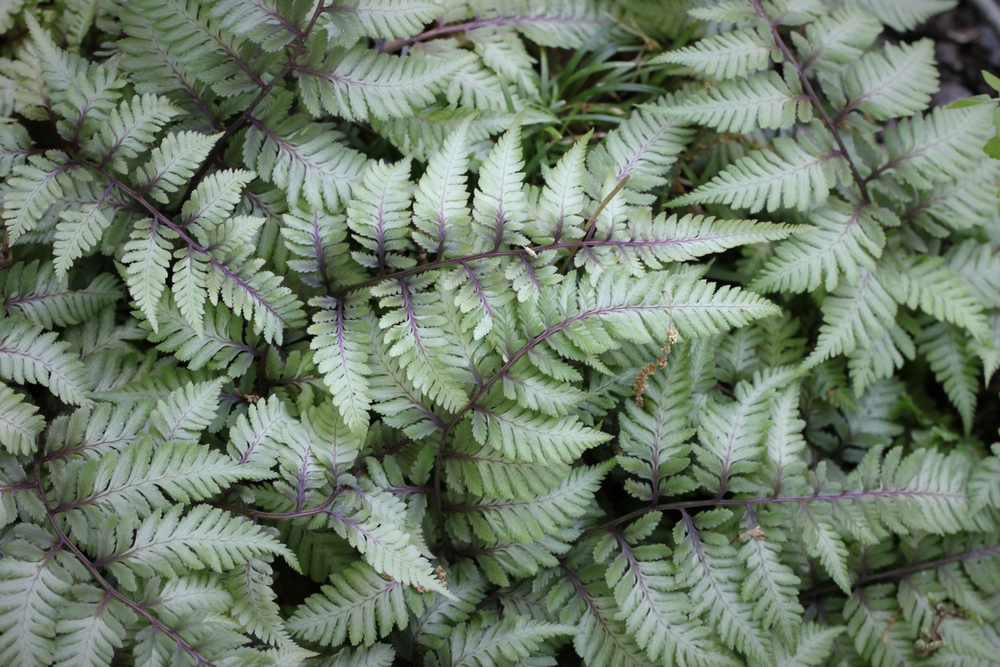
The Japanese painted fern stands out in autumn because its fronds blend silver, green, and soft purplish tones that shift as the season progresses. Cooler temperatures often intensify these shades, giving the plant a slightly deeper look that fits well among warm fall colors. The delicate pattern on each frond catches even small amounts of light, which helps brighten shaded areas without overpowering the rest of the garden. This unique mix of tones gives shaded beds character at a time of year when many plants begin to fade.
The plant’s gentle arching form adds movement and softness to woodland-style plantings. Gardeners love how it complements coral bells, hostas, and other shade plants that rely on foliage for interest. When placed among darker plants, the silvery fronds stand out just enough to draw the eye without overwhelming the scene. It brings a sense of balance to shaded gardens, especially when combined with plants that offer warm gold or rust tones.
Maintenance stays simple through autumn, making this fern a reliable part of low-light areas. Its fronds remain attractive well into the fall season, and in many gardens they gradually shift to soft golden or bronze tones before winter arrives. This seasonal change lets the plant contribute to the mood of the garden from early fall to the last mild weeks. Japanese painted fern supports the layered look many gardeners aim for in shaded landscapes, and its cool tones offer a gentle contrast to traditional autumn colors.
Autumn Fern
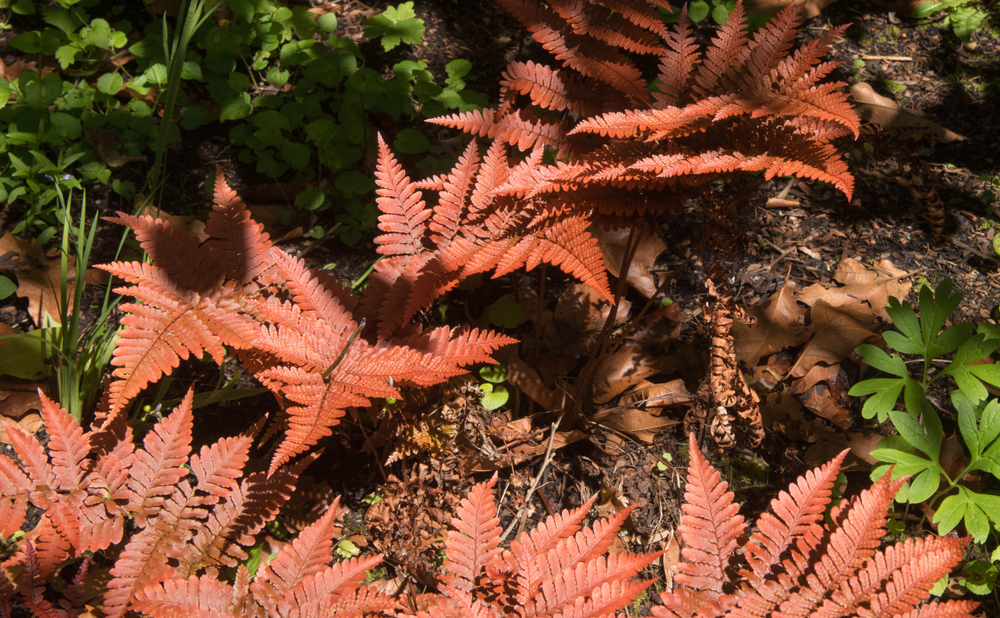
Autumn fern brings warm copper and russet tones to shaded gardens as the season cools. Its new fronds often carry a soft orange tint that slowly shifts to deep green, creating a layered look that fits the season well. The way the colors change adds steady interest, especially in areas where flowers have finished blooming. Even in lower light, the fronds catch small traces of sun, making the plant stand out without overwhelming the garden.
The plant’s arching habit gives shaded beds a graceful flow, and it pairs nicely with coral bells, hostas, and woodland grasses. Gardeners appreciate how the fronds stay fresh for a long stretch of the season, giving the garden some life as the days grow shorter. When grouped, autumn ferns can create a calm and earthy effect that fits well with the softer tones of fall. Their mix of warm and cool colors helps tie different parts of a shady bed together.
Because autumn fern stays strong through early frosts, it remains attractive later than many perennials. Even as colder nights come in, the fronds hold their shape, letting the plant keep the garden from looking flat or empty. This makes it a popular choice for gardeners who want lasting color in spots that do not see much sunlight. With steady growth and rich tones, autumn fern remains one of the most dependable shade plants for fall interest.
Solomon’s Seal
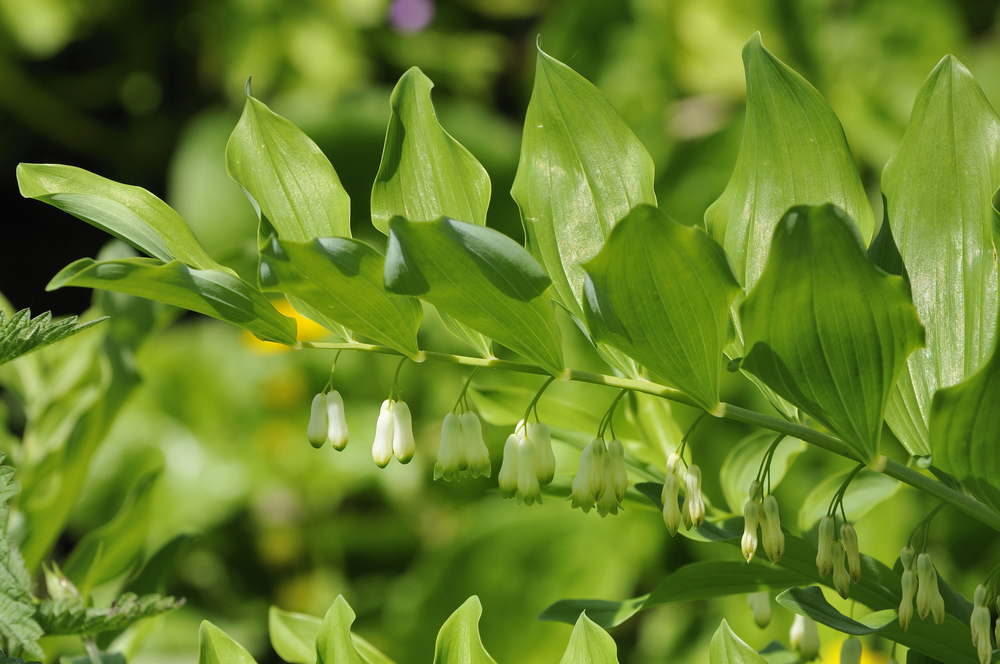
Solomon’s seal has a gentle drape that looks elegant in shaded corners, and its arching stems gain warm yellow tones during autumn. The leaves turn soft gold before dropping, creating a warm splash of color that suits the season perfectly. In many gardens, the plant becomes brighter as surrounding foliage begins to fade, making it a refreshing change in areas with limited light.
The plant’s tall stems create movement that helps break up heavy plantings of hostas or ferns. The slight sway of the stems adds depth and helps the garden look alive even on calm days. Gardeners enjoy placing Solomon’s seal along pathways or under trees where its shape stands out against darker backgrounds. It fills spaces gently while keeping a natural woodland look.
As temperatures fall, Solomon’s seal continues to hold its leaves longer than expected. Even when the plant finally prepares for winter, the stems remain attractive for some time. This gives shaded gardens a touch of late-season structure and helps prevent bare areas from appearing too soon. Its warm tones and gentle shape make it a valuable part of any autumn planting.
Toad Lily

Toad lilies bloom late in the year, sending out small star-shaped flowers when many plants have finished. Their blooms often show speckled shades of purple, lavender, or white, giving shaded corners an unexpected touch of color. Gardeners appreciate how the flowers appear in clusters along arching stems, adding a refined look that stands out against fall foliage.
The plant grows well under trees and near shrubs where light is filtered. Its upright shape helps add height to the back or middle of shaded beds, filling gaps left by summer plants. Even without flowers, the foliage stays fresh and holds color well into autumn. The combination of steady leaves and detailed blooms makes toad lilies feel special during the later part of the season.
They handle cool temperatures comfortably, allowing flowers to last longer than many would expect. As nights become chilly, the blooms remain bright, creating small bursts of color that keep the garden interesting. This late flowering habit makes toad lilies a favorite for gardeners who want their shaded areas to remain lively into October.
Black Mondo Grass

Black mondo grass offers dramatic, dark leaves that deepen in tone during autumn. The narrow blades turn nearly charcoal in cool weather, making them stand out against green ferns and coral bells. This contrast can make a shaded garden feel more textured without the need for flowers. The plant forms tidy clumps that stay attractive throughout the season.
Gardeners use black mondo grass to outline borders, fill narrow spaces, or create small contrasting accents. Its compact size allows it to fit in areas where larger shade plants might feel crowded. When paired with silver or gold-toned companions, the deep color of this grass brings out the warmer shades of autumn. The clean shape helps add subtle order to informal shaded gardens.
The plant holds up well through temperature shifts and keeps its dark tones even as other plants begin to fade. It remains attractive close to winter, giving gardens a soft grounding element while other plants lose their leaves. Its strong color and neat form make it a helpful addition for autumn gardens in low light.
Lungwort
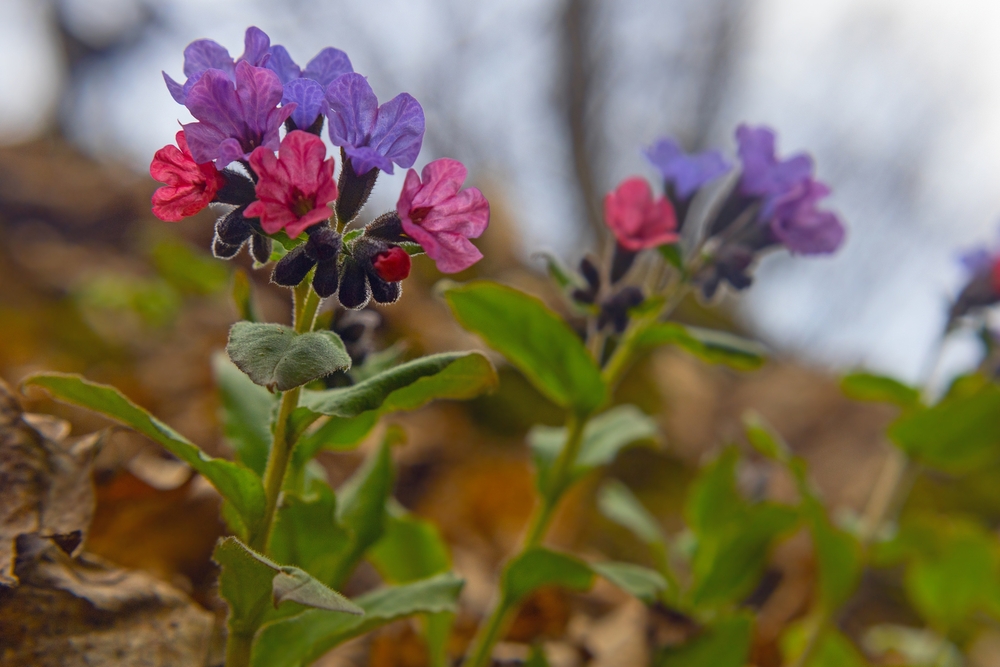
Lungwort shows off its speckled or silvery leaves through the entire growing season, and those patterns often become more pronounced in autumn’s cooler air. The foliage stays lush even in deep shade, adding brightness where other plants might fade. These leaves can take on a slightly deeper tone in the fall, giving the plant a pleasing contrast with golden hostas or russet ferns.
The plant forms low mounds that help fill open spaces beneath trees or along shaded pathways. Gardeners enjoy how lungwort creates a natural look that complements coral bells, ferns, and woodland flowers. Even though its spring blooms are long gone, the foliage alone keeps the plant visually interesting during autumn. This makes lungwort a helpful choice for long-lasting displays.
As cool nights move in, the leaves remain sturdy and continue to reflect bits of light, helping shaded beds look awake. The plant holds its form well until frost, offering color and texture late into the season. Its long-lasting leaves help prevent shaded gardens from feeling empty as the year winds down.
Bergenia

Bergenia develops deep red or purple leaf edges during autumn, giving shaded gardens a warm and dramatic touch. As temperatures drop, the foliage thickens and gains richer tones, creating a strong presence in low light. Gardeners like how these shifts add steady color even when flowers are absent, making bergenia valuable for autumn displays.
The plant has thick, leathery leaves that form solid clumps, giving shaded beds structure that lasts well into the cooler months. This shape helps anchor softer plants like ferns and woodland blooms, creating balance in areas with filtered light. When grouped, Bergenia can create a sweeping effect that brings depth to shaded corners. Its ability to maintain visual weight helps shaded gardens hold interest late into the year.
In cooler regions, the foliage often keeps its red hues for an extended stretch. The plant stays attractive through early frosts, offering color at a time when many plants have already declined. This durability makes it a steady choice for gardeners who want reliable autumn foliage without heavy upkeep.
Japanese Forest Grass
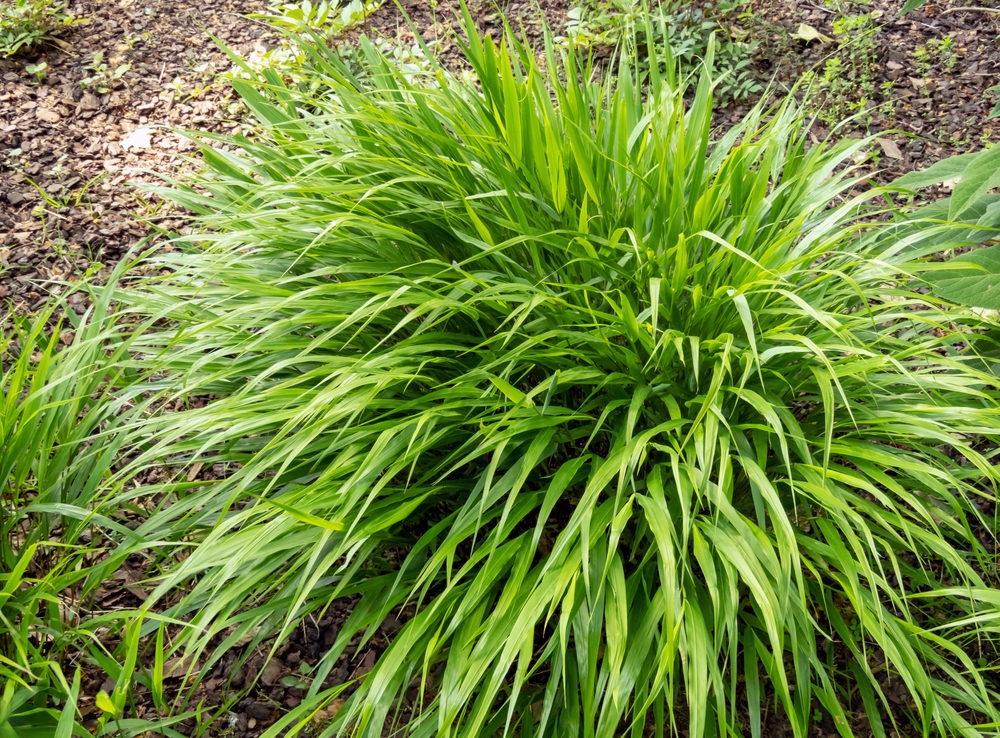
Japanese forest grass shifts toward warm gold or soft bronze tones during autumn, bringing brightness to areas with filtered light. Its long, arching blades create flowing movement that fits the mood of the season. As the plant changes color, it catches rays of afternoon sun and helps illuminate the darker corners of the garden.
Gardeners often use this grass to border pathways or to soften the base of shrubs and trees. Its graceful form blends well with ferns, hostas, and woodland perennials, giving beds a layered and natural look. While it stays relatively low, the shape adds motion and prevents shaded areas from feeling heavy. Its shifting tones pair well with plants that show deep fall colors.
Through autumn, the grass holds its color longer than many ornamental varieties. Even when temperatures fall, its blades remain attractive and maintain shape. This makes it a useful plant for anyone wanting movement, color, and softness late into the season.
Epimedium

Epimedium keeps its foliage well into autumn, and many varieties gain red, bronze, or warm yellow tones as the season progresses. These color changes can give shady beds a lively glow that catches attention even under trees. The heart-shaped leaves create a soft, textured display that stands out against darker plants like black mondo grass.
Gardeners appreciate how epimedium creates natural groundcover without feeling overwhelming. It works well in large sweeps or small clusters, blending easily with ferns and woodland flowers. The plant remains tidy as temperatures cool, giving shade gardens a more complete look in autumn. Its flexibility makes it easy to fit into many garden styles.
Because epimedium tolerates temperature dips, the foliage often stays fresh through the first frosts. The warm hues can linger well into late fall, helping the garden look colorful even as other perennials fade. This long-lasting display makes it one of the more reliable choices for shaded gardens in autumn.
This article originally appeared on Avocadu.
